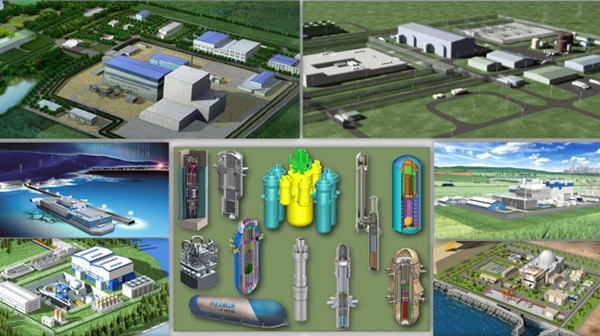New safety recommendations for small modular reactors (SMRs) are now available, following a meeting in Vienna on 25-28 March of the SMR Regulators' Forum, a group of experts working on the development of national standards specific to SMRs. The International Atomic Energy Agency (IAEA), which hosts the forum, says it does not currently have plans to develop safety standards specific to SMRs.

SMR technologies (Image: IAEA)
Founded in March 2015, the SMR Regulators' Forum gathers nine countries and other stakeholders sharing SMR regulatory knowledge and experience. Together, they identify and propose solutions to common safety issues that may challenge regulatory reviews associated with SMRs.
Although the IAEA safety standards - which serve as a global reference for protecting people and the environment from the harmful effects of ionising radiation - can generally be applied to SMRs, experts from the SMR Regulators' Forum are working on a tailor-made solution to help national authorities regulate this new class of nuclear power reactors.
Small, compact reactors of up to 300 MWe in capacity - around a third of the size of a typical commercial nuclear power plant - can potentially offer a range of strengths in terms of safety, construction and siting as well as potential economic benefits. Their modular 'plug and play' nature means that they could be made in factories and transported to generation sites, offering economies of scale and reducing both capital costs and construction times. Their small size makes them suitable for small electric grids and locations that cannot support large reactors, while offering the flexibility to install units individually or as modules in a larger generating complex, adding more modules incrementally as required. As well as using a simpler reactor design, SMRs can incorporate a high level of passive or inherent safety in the event of malfunction.
The SMR Regulators' Forum has published online new recommendations on safety implications that arise from the use of modularity and compactness of SMRs and on the SMR lifecycle licensing framework.
"Most SMRs are designed to be compact in order to enable their manufacture at a factory and to facilitate their transportation to the plant site," said Karine Herviou, Director at France's Institute for Radiological Protection and Nuclear Safety (IRSN) and member of the SMR Regulators' Forum. "The modularity and compactness inherent to SMRs may have safety implications and introduce new challenges to the SMR lifecycle, associated with design, construction, commissioning, operation and decommissioning stages."
Herviou said the compact nature of SMRs may prove challenging when it comes to performing the necessary inspections, operations and maintenance, not only during the manufacturing stage, but for the entire life cycle of the SMR. "In addition to novel design features and approaches, SMR projects may indeed introduce several differences to new-build projects, ranging from factory manufacturing and testing, to new construction and commissioning methods.
Multi-module SMR designs may have certain operational and safety benefits, Herviou noted, but may require specific consideration for nuclear safety, emphasised by the lessons learned from the multi-unit Fukushima-Daiichi nuclear power plant accident. "The SMR Regulators’ Forum considers that it would be beneficial for both designers and regulators to think beyond the single unit mindset. This might involve extending their considerations to whole site risk including developing methods of aggregating risk from differing on-site sources," she said.
The Forum's work is expected to result in: position statements on regulatory issues; suggestions for revisions to or new IAEA documents; information to help regulators enhance regulatory frameworks; reports on regulatory challenges with discussion on paths forward; and suggestions for changes to international codes and standards.
"The work of the SMR Regulators' Forum allows us to better understand the current state of practice and challenges in licensing of SMRs," said Greg Rzentkowski, director of IAEA's nuclear installation safety division. "Although currently we have no plans to develop specific safety standards for SMRs, we will use these insights in the establishment of our holistic, technology neutral, framework for safety of nuclear installations, which also applies to novel designs, to help harmonise international approaches by using the IAEA safety standards." To be effective, the regulators must be prepared to recalibrate the current model of regulations by increasing reliance on risk and performance insights, he added.
Researched and written by World Nuclear News